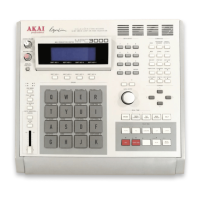Chapter 3: Recording Sequences
Page 40
It is also possible to punch-in to Record mode while playing. To do
this:
1. The MPC3000 must be in Record Ready mode. (The top
line of the Play/Record screen must display the words
Play/Record (Record ready).) If not, simply
press and release the RECORD or OVERDUB key once
while the sequence is stopped.
2. While the sequence is playing, simultaneously press the
RECORD and PLAY keys. Record mode is now active, as
indicated by the light above the RECORD key.
To punch-out of Record mode, simply press the RECORD key once,
and the light above the RECORD key will turn off.
COMMENT: If Record mode is entered while the sequence is
set to loop to bar number1 (or a portion of the sequence is
looped with the Edit Loop function), Record mode automati-
cally switches to Overdub mode at the moment the sequence
reaches the end and starts to loop. This prevents accidental
erasure of any data that were recorded on the previous pass
through the loop. If, however, Record mode is entered while
the sequence is set to loop to a higher-numbered bar than bar
1, Record mode will automatically be turned off at the
moment the sequence reaches the end and starts to loop.
COMMENT: If an empty sequence is selected (the sequence
name field shows “unused”), and either RECORD or OVER-
DUB is pressed, the sequence will instantly be initialized
using the settings in the Initialize Sequence screen. This
function is normally accessed by pressing the ERASE key
and selecting SOFT KEY 2.
• The REWIND [<<] and FAST FORWARD [>>] keys:
Use these two keys to change the current position within the se-
quence to either the previous or next bar boundary. The actions of
these keys repeat when they are held.
• The REWIND [<] and FAST FORWARD [>] keys:
Use these two keys to move the current position within the sequence
to either the previous or next note boundary, as determined by the
value in the Note Value field of the Timing Correct screen
(normally set to 1/16 NOTE). To change the amount of movement,
simply change the setting in this data field. The actions of these
keys repeat when they are held.
While the Step Edit function is active, it is possible to set these keys
to an alternate function—to search to the previous or next event of a
specific type within the track. To learn how to do this, see the “Step

